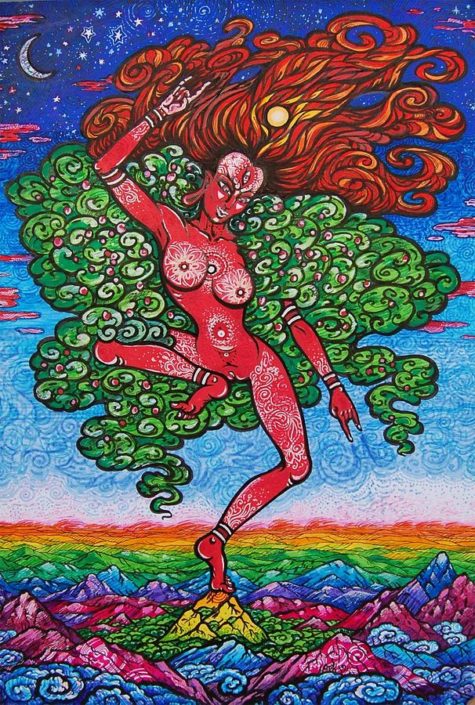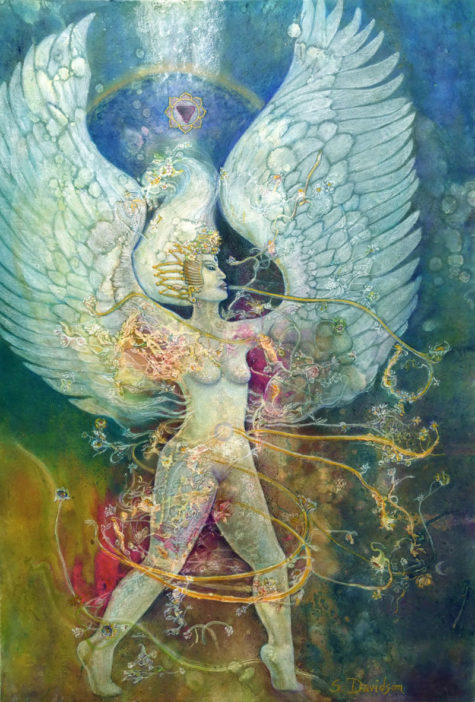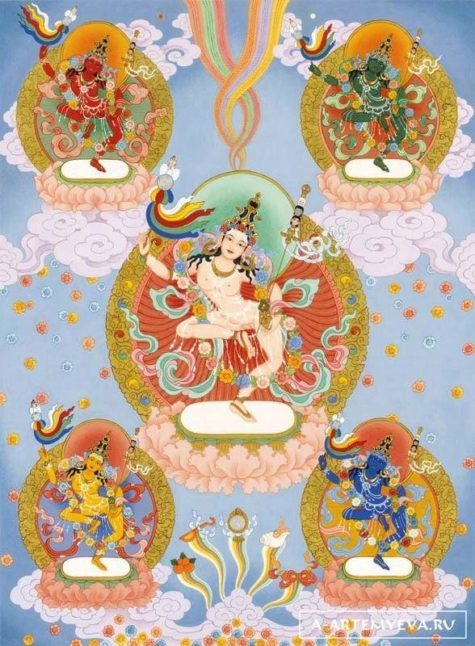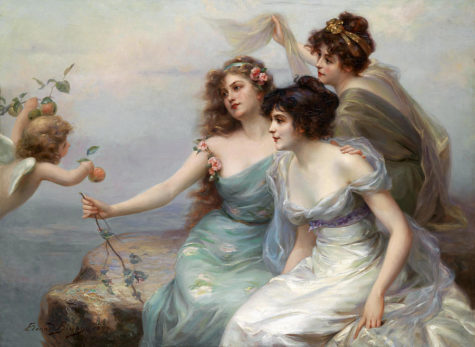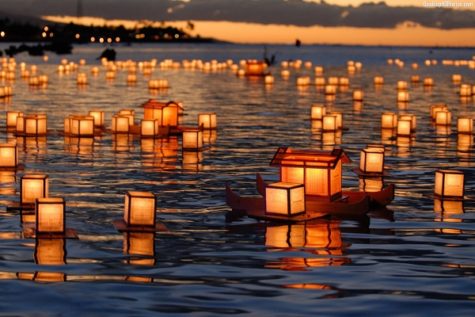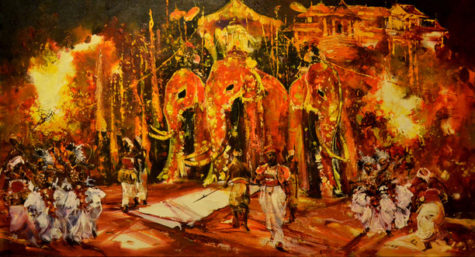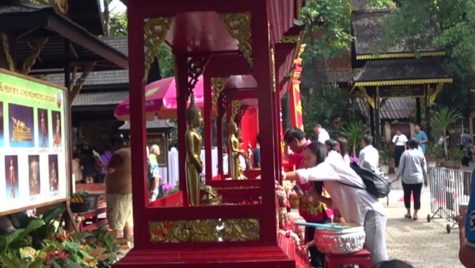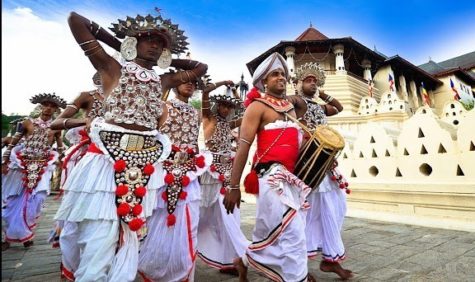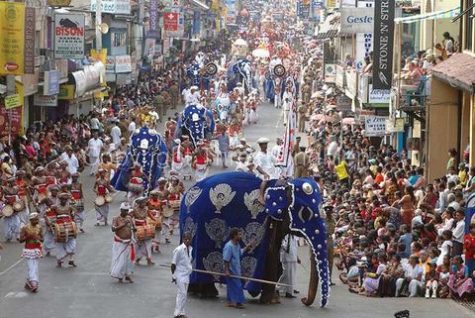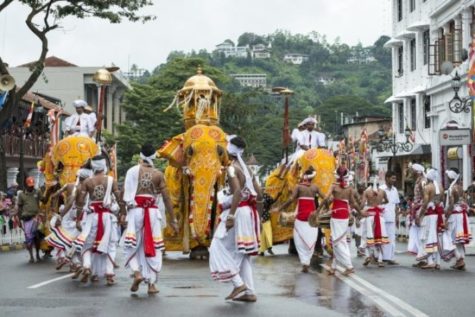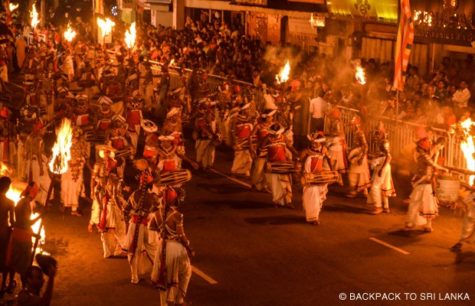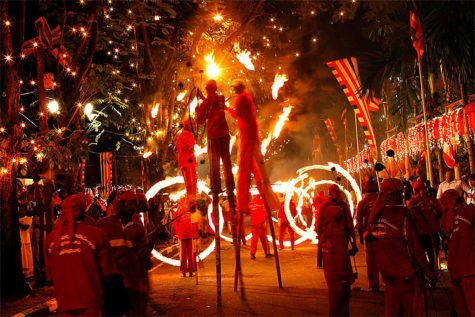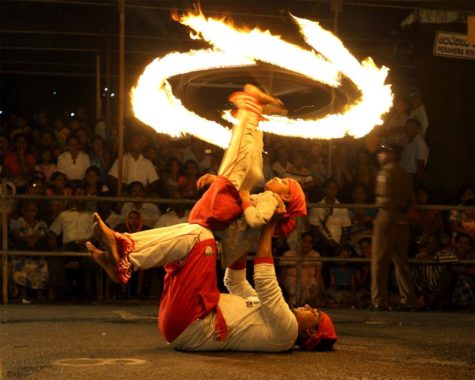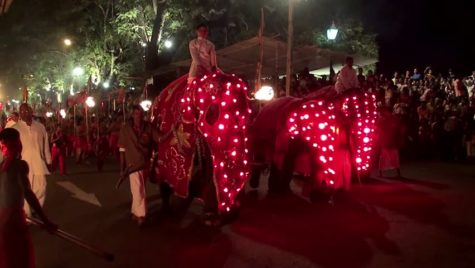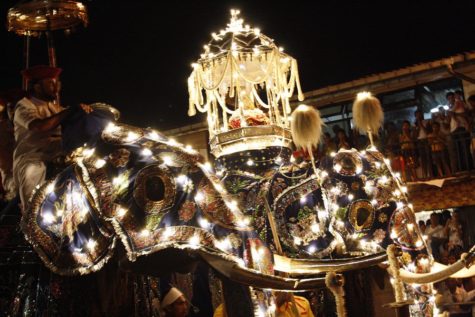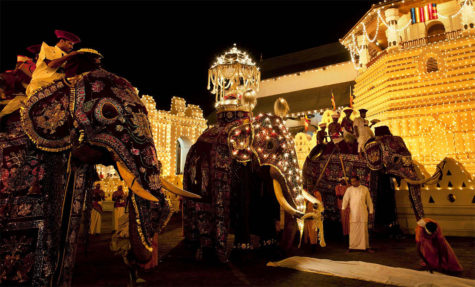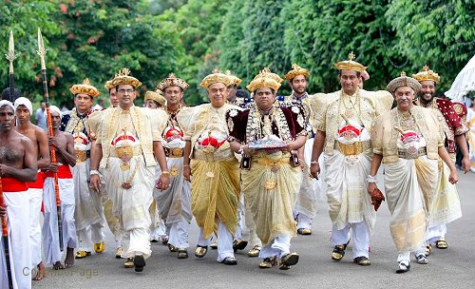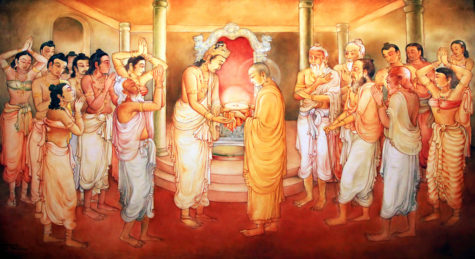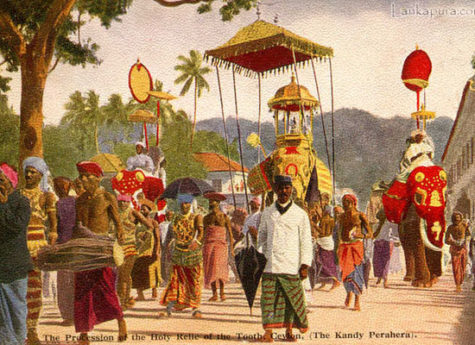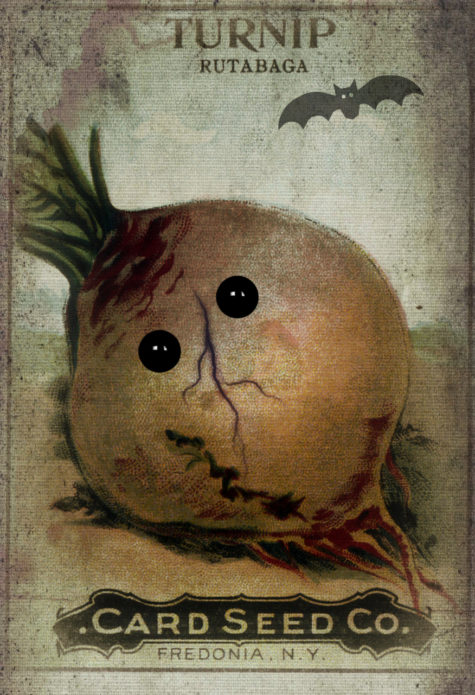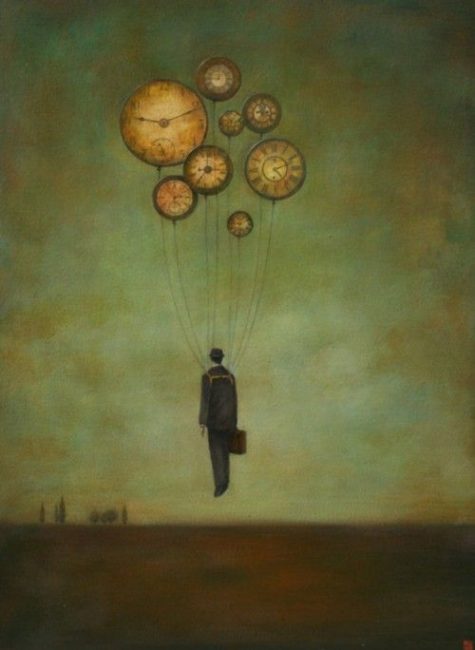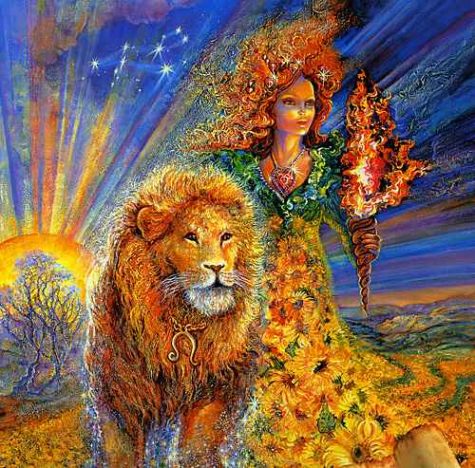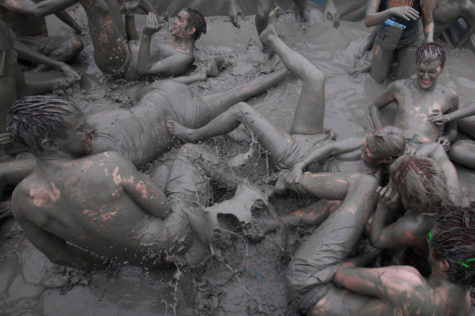July
Dakini day, celebrated on the 25th day of each lunar month in Vajrayana Buddhist traditions, celebrates the feminine energy of wisdom. Devoted Buddhists will celebrate with a Tsok (Tsog), a feast including food, singing, a group (or single) sadhana full of sound and celebration. Most Tibetan Buddhist temples and meditation centers try to arrange a monthly Tsog on this day each month, with celebrants bringing food as offerings. It is always a happy day, that invites blessings not only for the attendees, but for all sentient beings.
This is one of the special days during a month, when Vajrayana practitioners perform a ritual of offering and purification of their commitments. It is believed that on this particular day, all the Dakinis gather in special sacred places and their energy is potently vivid and present at that moment.
When we perform practice on those auspicious days, we can connect with this potent energy and thus gain a lot of merit. It allows us to develop our practice and capacities, as well as purify our defilements and mistakes that we have accumulated with time. In this way, Dakini Day becomes very important for Vajrayana practitioners.
What is a Dakini?
The Dakini is a female being of generally volatile temperament, who acts as a muse for spiritual practice. Dakinis can be likened to elves, angels, or other such supernatural beings, and are symbolically representative of testing one’s awareness and adherence to Buddhist tantric sadhana.
Dakinis are portrayed as elusive, playful and often fierce and naked to symbolically convey how elusive true Wisdom encompassing “Emptiness” can be.
Without contradiction to their role as exemplars of Emptiness, Dakinis can also represent fierce activities, such as protection — the ferocious protective love of a mother.
Khandro Rinpoche defines the authentic Dakini principle as “a very sharp, brilliant wisdom mind that is uncompromising, honest, with a little bit of wrath.”
Dakinis appear in many forms. “The Dakinis are the most important elements of the enlightened feminine in Tibetan Buddhism,” says American teacher Tsultrim Allione. “They are the luminous, subtle, spiritual energy, the key, the gatekeeper, the guardian of the unconditioned state. If we are not willing to invite the Dakini into our life, then we cannot enter these subtle states of mind. Sometimes the Dakinis appear as messengers, sometimes as guides, and sometimes as protectors.”
Dakini are timeless, inorganic, immortal, non-human beings who have co-existed since the very beginning with the Spiritual Energy. In some New Age belief systems, they are angelic. This New Age paradigm differs from that of the Judeo-Christian by not insisting on angels being bona fide servants of God.
Moreover, an angel is the Western equivalent of a Dakini. The behavior of Dakini has always been revelatory and mysterious; they respond to the state of spiritual energy within individuals. Love is their usual domain – one explanation for Dakini or angels supposedly living in the sky or heaven. Manifestations of Dakini in human form occur because they supposedly can assume any form. Most often they appear as a human female. By convention, a male of this type is called a ‘Daka’.
In Buddhism, typically, the male Buddhas represent compassionate means, while the female Buddhas represent Wisdom. The symbols of bell and vajra (Ghanta and Dorje) represent female wisdom — the bell, which makes the sound of “Emptiness” — and the Vajra, representing compassionate means.
Dakini’s have always been a part of Buddhism, starting with the Jataka’s (stories of Buddha’s former lives) in which “divine beings are described as travelling through the air. In Sanskrit, such a being is called a Dakini, a term generally translated as “space-goer,” “celestial woman,” or “cloud fairy.”
Dakinis are typically thought of as the emanation of the “Enlightened Mind” understanding Emptiness. Another concept usually tied to Dakini practice is “bliss” — the state of blissful awareness of emptiness.
It is a wonderful experience to have a moment that realizes emptiness, a feeling of joy-bliss rather than “nothingness.” This is why Dakinis are often portrayed as active, dancing, joyful or fierce, naked and unencumbered.
Five Dakini Healing Mantra
The meaning of Dakini is the female enlightened energy and the awakened state of consciousness. Therefore, chanting this mantra increases and enhances all enlightened feminine energy.
Bam Ha Ri Ni Sa
The 5 Dakini also represents each of the 5 Elements:
- BAM ~ Buddha Dakini ~ (blue) ~ Mind energy, pacifies Ignorance
- HA ~ Vajra Dakini ~ (white) ~ Body energy, pacifies Anger
- RI ~ Ratna Dakini ~ (yellow) ~ Knowledge/Qualities/Healing, pacifies Ego/Pride
- NI ~ Padma Dakini ~ (red) ~ Speech energy, pacifies Desire
- SA ~ Karma Dakini ~ (green) ~ Action/Removes Obstacles, pacifies Jealousy
This mantra is helpful for all female related health issues, transforms negative emotions, unblocks channels, and balance 5 elements. When chanting this mantra on Dakini Day, the power magnifies ten-fold!
After chanting, blow into a glass of water, which infuses the healing vibration into the water, drink, and continue to enjoy its healing properties.
Sources:
There is not a lot of information about this particular feast day and the dates given for it vary widely. Our calendar lists it as January 30 – 31, but some calendars assign it to January 17 – 18, others say April 18 – 19, May 26, July 9 – 10, or October 13. None of these calendars have any information other than that it is called “Feast of Charities” for the Greek goddesses known as the Graces. I don’t think anyone really knows much about it.
I did find a Feast of the Charities Ritual at Llewellyn. Here it is:
- Color of the day: Orange
- Incense of the day: Sage
Today is the Feast of the Charities. These old Greek goddesses of beneficence were known to the Romans as the Gratiae, or “Graces.” They are Aglaea, whose name means “splendor,” Euphrosyne, or “joy,” and Thalia, or “mirth.” The Charities bestow charm, beauty, and creativity on their worshipers. In this regard they serve a similar purpose to the nine Muses. Generosity and festive activities please these goddesses.
- Get some friends together and dress up.
- Arrange each other’s hair.
- Dance and sing, or perform some sacred theater.
- Visit an art gallery or walk through a street fair.
Alternatively, do something nice for the less fortunate. Bundle up old clothes you never wear anymore to recycle for the less fortunate, or hold a food drive and donate the results to a local charity. (Yes, the term comes from the name of these goddess, “Charities.”) You could also donate your money or time. Give of yourself, and you shall receive “grace” from the Charities in return. Be kind and giving, and your creativity will overflow!
According to Japanese Buddhist belief, every summer at this time spirits of the dead return to visit their families. O-Bon is a Buddhist ceremony for welcoming back and appeasing the souls of our ancestors.
During the course of this festival, the souls of the dead are guided home, feted for several days, and then sent back to the spirit world.
The formal name of this festival is Ura-Bon, and generally falls on Aug 13 thru Aug 15. Depending on the region, however, the Bon Festival may be held one month earlier, or July 13th-15th.
The word O-Bon has its roots in the Sanskrit word ullambana, which means ‘deliverance from suffering’. The festival combines early Buddhist rituals designed to rescue the souls of the dead from hell, with native Japanese agricultural rites and the Shinto tradition of welcoming back the souls of ancestors in late summer.
Traditionally, the bones of the deceased are placed in individual urns and kept with their ancestors in a family tomb (ohaka). For several consecutive evenings during the week of O-Bon, paper lanterns painted with the family crest are hung to guide the ancestral spirits to the ohaka.
Alternatively, small welcoming fires (mukaebi) may be lit at the entrance to the home, or in front of the gate early on the evening of the 13th to receive the souls of the ancestors.
It is also customary at this time to clean the family grave and present fresh flowers and incense. Those who are unable to travel to their family burial place may instead spruce up the domestic altar. Houses are cleaned and decorated and a place is sometimes set at the family table for the recently departed.
Although many Japanese also hold Shinto beliefs, it is Buddhism that is associated with rituals concerned with death. Therefore it is the Buddhist household altar — the butsudan — that remains the focus of attention during O-Bon.
Offering stands and a small tray with tiny dishes for the symbolic meals offered to the ancestors are brought out, and a special shelf (Shoryodana or ‘Shelf of Souls’) is set up in front of the altar; it is here that, for the duration of O-Bon, the spirits are believed to dwell.
At the end of three days (on the 16th), the lanterns are again set out to guide the spirits back, and an okuribi (farewell) fire is lit to see off the souls of the ancestors.
Collected from various sources including Mythic Maps
The Festival of the Tooth – An extended and lavish holiday which commemorates a holy relic of Buddha, his eye tooth.
Kandy is a beautiful city in Sri Lanka. On a small hill is a great temple which was especially built to house a relic of the Buddha – his tooth. The tooth can never be seen, as it is kept deep inside may caskets. But once a year in August, on the night of the full moon, there is a special procession for it. But other festivities occur on ten days leading to that final day.
The dates of the festival vary from year to year. In 2017, the festival runs from July 29 thru August 8th. The Festival begins with the cutting of a sanctified young jack tree. Branches of the tree are then planted near the shrines of the four guardian gods Natha (a Buddhist savior), Vishnu (for safeguarding Buddhism in Sri Lanka), Kataragama (protector of the south) and the goddess Pattini (goddess of health and fertility). Traditionally, this was a ritual performed to ask the gods for blessings on the King and the people.
For the next five nights, festive dancing and drumming are held outside each of the temples. On the sixth night of the festival, processions begin from each shrine and parade toward the Temple of the Tooth. The processions get longer and more magnificent for the next three nights.
The highlight is on the last night of the processions: an enormous elephant carries a gold casket containing a replica of the Tooth Relic as the drummers and dancers enthrall the crowd along the route. The drummers and dancers themselves are followed by elephants and other groups of musicians, dancers and flag bearers.
After nights of processions, a water cutting ceremony brings the festival to an end at dawn, when priests representing each of the four temples walk into the Mahaweli River, “cut” a circle in the water with a sword and fill pitchers with water from within the circle. The water is kept till the next year’s Esala Perahera, when the pitcher will be freshly filled again.
The next day, Kandyan chieftains in ancient regalia, march to the Presidential mansion in Kandy, following royal tradition, to report to the Head of State, the successful completion of the annual event.
The story behind the tooth is as follows:
It was believed that if the Bodhi Tree that came into contact with the Buddha had the power to bring rains, then the parts of His own body had much greater power to invite rains. With this in mind, the sacred tooth relic was brought all the way from Kalinga in India to the island of Sri Lanka in the fourth century AD. At the time, the sacred tooth relic was brought to Sri Lanka, the king was Sri Megha varna. His name itself meant ‘the Resplendent one whose complexion is that of the Rain-cloud’.
The time when the sacred tooth was brought to Sri Lanka was around six centuries after the sapling of the sacred Bodhi Tree was brought into the island country. However, very soon, the popularity of the sacred tooth surpassed that of the Bodhi Tree. The simple reason for this was that it could be moved any number of times from one place to another, very unlike the Bodhi Tree itself. Also, the possesion of the tooth relic soon became a matter of power and claim to rule the land. The king who had possession of the tooth relic had the authority to rule the land and, wars were fought to keep the relic from falling into hostile hands.
This is amply manifested in the attempt made by the kings when the Europeans enhanced their power in the island country. King Senarath quickly transported the relic a little distance away from Kandy when the Portuguese came to close for his comfort. Later, the significance of the tooth relic became known to the Europeans themselves. They wasted no time and made it their primary goal to get hold of the precious relic. The British succeeded in 1818, and the people themselves gave up all efforts to prevent the former from ruling them, all because the British possessed the tooth relic.
Historically, a number of festivals were celebrated to honor the sacred tooth relic right from time it came to Sri Lanka. Initially, processions or peraheras were taken out for the tooth relic alone. However, later, the festival was incorporated with another festival meant to appease the rain god, the Esala peraheras. At this time, a Kandyan king, Kirti Shri Rajasinghe was in power and he made it possible for the common people to worship the relic by announcing that it would be taken out in a procession for the masses to see and offer their prayers. Before this, the tooth relic was the property of the king and the common people were not allowed to worship it.
Source: Wikipedia and My Odyssey Tours
Today, July 25, is a Day Out of Time. This is the last day of the galactic year in the Mayan and Galactic calendar.
Here’s the math:
13 moons of 28 days = 364 days.
The extra day, the 365th day, is July 25.
This is why it is called “Day Out Of Time”
This is a special day for ritual, meditation and prayer.
Source: Souled Out
July 24, Pioneer Day commemorates the day in 1847 when Brigham Young led his “pioneer band” of Mormons into the Salt Lake valley to establish a settlement–their new Zion. The Mormons had been driven from New York, Ohio, Missouri, and Illinois and had spent four difficult months traveling 1,073 miles overland to reach the Great Basin, chosen by Young because of its remoteness.
It was the most organized and disciplined westward migration in American history, and unlike most emigrants intent on their destination, the Mormon pioneers were equally concerned with improving the trail for those who would follow.
Pioneer Day is celebrated as the second most important date in the Mormon calendar, behind April 6, the day Joseph Smith established the church. Parades, fireworks, rodeos, and other festivities help commemorate the event.
From: Almanac.com
Leo is the fifth sign of the zodiac. The sun enters Leo at slightly different times each year, usually around July 22, sometimes the day before or the day after.
- Symbol: Lion
- Element: Fire
- Gemstone: Sardonyx
- Keyword: I Will
Leos are ambitious, determined, and enthusiastic. They like to do everything in a large way, and express themselves openly, honestly, and confidently. They are proud people who dislike being ridiculed or demeaned. They are generous, magnanimous, and susceptible to flattery. Their enthusiasm means that they sometimes get carried away and exaggerate or distort the truth, as they like to tell a good story. They make good leaders, as they have the ability to inspire and motivate others.
From 365 Goddess, we have this for today:
- Themes: Devotion; Strength; Sun; Magic; Passion
- Symbols: Lion; Strawberries
- Presiding Goddess: Freyja
About Freyja:
In Nordic tradition, Freyja’s name means “lady.” Generally speaking, it is her domain to care for matters of the heart. In mythology, Freyja is stunningly beautiful, a mistress to the gods, and she appears driving a chariot pulled by cats. When saddened, Freyja cries gold tears, and she wears a shining necklace (alluding to some solar associations). Many people in northern climes credit her for teaching magic to humankind.
To Do Today:
In astrology, people born under the sign of Leo are energetic and filled with Freyja’s solar aspect. And, like Freyja, they are ardent, dynamic lovers. If your love life needs a pick-me-up, Freyja’s the goddess to call on. Start with a bowl of strawberries and melted chocolate that you feed your lover. Remember to nibble passionately while biting into Freyja’s sacred food! This will digest Freyja’s energy for lovemaking. If you’re still single, eat a few berries at breakfast to internalize self-love so more loving opportunities will naturally come your way.
To improve love in other areas of your life (the love of friends, love for a job or project, etc), wear gold-toned clothing or jewelry today to emphasize Freyja’s solar powers. This will give you more tenacity, focus, and esteem for whatever you’re putting your hands and heart into.
More About the Sun in Leo:
The Sun is in Leo from approximately July 21 to August 20, depending on the year.
- Ruler: The Sun
- Modality: Fixed
- Season: Summer
- Metal: Gold
- Stone: Ruby
- Color: Orange, Gold
- Flowers: Gladiolas, Orchid, Sunflower, Lavender
- Anatomy: The heart.
- Attributes: magnanimous, generous, hospitable, caring, warm, authoritative, active, open
There’s an unmistakably regal air to Solar Leos. These are dignified—even noble—folk. Leos have a reputation for being conceited, but think again. Leos do feel important, but this generally takes the form of wanting to change the world in some way—to make the world a better place. They are generally motivated by affection for people, and often have big dreams and plans to make people happy.
Generally, Leos are hard-working. After all, they are attracted to the good things in life, and they know they have to work to get them. It is sometimes difficult to imagine Leos as go-getters if you happen to catch them in one of their languid moods. These people can sleep in, laze around, and luxuriate for long periods of time. However, when they do get to work, they do it with intensity and determination. In this way, they are not unlike their symbol, the lion.
The worst thing you can do to a Leo is accuse them of bad intentions. Displaying behavior that makes them think you don’t appreciate them runs a close second. These happy, jovial people become mighty hurt when others don’t see them for their noble intentions.
Loyal, and sometimes rather traditional, Leos are, after all, a fixed sign. They’ll hold on to situations and people for a very long time before they give up. There is an unmistakable idealism to Leo’s view of the world and the people in it. Often, Leos have a very noble inner code that they answer to. Although on the surface, Leos appear rather confident, they can actually be some of the most humble souls around. They are the first to blame themselves when something goes wrong. Once again, it’s the Leonine self-importance at work, and this characteristic works in unexpected ways. Instead of being the conceited, self-absorbed show-offs of reputation, they are usually very self-aware, self-conscious, and, yes, even humble.
Source: Cafe Astrology
St. Swithin was a beloved ninth-century bishop of Winchester, England, who requested that he be buried in the churchyard–some say to be close to the common people, whom he loved; some say so that he could enjoy God’s gift of rain for all eternity. When he died in 862, his request was honored.
About 100 years later, however, it was deemed unseemly that so holy a man should rest in a common grave. On July 15, the saint’s feast day, the people attempted to enshrine his remains in his church.
Legend has it, however, that St. Swithin caused torrential rains to fall for 40 days, until the intended transfer was abandoned. This is the source of a very old Scottish weather proverb regarding rain on July 15:
“St. Swithin’s Day if thou dost rain,
For forty days it will remain.”
Source: Almanac.com
Boryeong, South Korea: The mud trucked in to Daecheon Beach for the festival is said to have cosmetic effects, but that isn’t why 2 million or so ex-pats, locals and tourists muck it up, slathering themselves in mud while slinging beer and soju in Ziploc bags. It’s just down-and-dirty fun. There’s also mud-skiing, a mud king contest, as well as fireworks at night. Tip: take a dip before you leave.
About This Festival
Getting dirty has never been so much fun. Beauty product for some, excuse to channel their inner child for others, Boryeong Mud means many things to many people. This filthy festival involves wrestling, sliding, massages, and photo contests. The dates vary from year to year. In 2016, it was held July 16 thru July 24.
A Dirty Marketing Idea is Born
The idea for the festival began in 1998 as a promotion for the mineral-rich mud found near Boryeong, South Korea. When the manufacturers of Boryeong Mud products determined the beneficial effects of their local mud, they invited visitors to slather themselves in the stuff. The event took on a life of its own rather quickly, attracting thousands of visitors to this otherwise sleepy town annually for the beach, the warm weather, and, of course, the mud.
Things Get Dirty Fast
Fueled by word of mouth, good times and exceptional photographs of mud people, the festival has become an international phenomenon. Families picnic under beach umbrellas, toddlers splash in the kid-friendly area, and the under-30 crowd (generally traveling English teachers, members of the military, and students) are the front-and-center partiers inside an inflatable mud wonderland. Festival-goers have their pick of competitive activities like the Mr. Mud contest, mud wrestling, mud races and even a mud boot camp. Those looking for a more laid back experience can opt for mud facials, body painting, pottery demos, soap-making and lounging on Daecheon Beach.
There’s no need to worry about getting all this gooey grey mud out of your hair, either: showers are abundant and available for a modest fee, as are lockers that can be used to store a fresh and clean outfit. Rinsing off in the ocean is also an option, albeit a less effective one if you plan to impress after your mudbath. Finally, after you’ve wallowed in Boryeong’s thick gray ooze, you can pick up some of the local beauty products, including mudpacks, mud shampoo, mud soap, mud sunblock – remember, this was the original intention of this festival!
More Than Just Mud
Although the main attraction is, of course, the mud, Boryeong features an impressive entertainment lineup as well. Pop and hip-hop performers from around the world affirm its status as an international event, providing an eclectic soundtrack to the wet and wild madness. Don’t miss the huge global rave on the evening of the closing ceremonies, or Friday’s Korean b-boy show. Keep your eye out for opening and closing night fireworks, as well as parades and other cultural performances during the week.
In the end, the thing that sets Boryeong apart is the mud play. The spirit of conviviality across cultures and ages is a function of the anonymity everyone experiences while covered in mud. As Jae-Sang Lee, Director of Korea Tourism Organization, says, “The most distinctive point of the Festival is to create a united place where people from all over the world come together, meet and interact with strangers and are able to break down walls of age, nationality, race and have fun together and leave with memories and new friends.” All are one under the mud.
Sources:
Everfest
Samuitimes
Mud Festival – The official page
